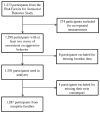Environmental Determinants of Aggression in Adolescents: Role of Urban Neighborhood Greenspace
- PMID: 27343886
- PMCID: PMC4924128
- DOI: 10.1016/j.jaac.2016.05.002
Environmental Determinants of Aggression in Adolescents: Role of Urban Neighborhood Greenspace
Abstract
Objective: Neighborhood greenspace improves mental health of urban-dwelling populations, but its putative neurobehavioral benefits in adolescents remain unclear. We conducted a prospective study on urban-dwelling adolescents to examine the association between greenspace in residential neighborhood and aggressive behaviors.
Method: Participants (n = 1,287) of the Risk Factors for Antisocial Behavior Study, a multi-ethnic cohort of twins and triplets born in 1990 to 1995 and living in Southern California, were examined in 2000 to 2012 (aged 9-18 years) with repeated assessments of their aggressive behaviors by the parent-reported Child Behavior Checklist. Normalized Difference Vegetation Index (NDVI) derived from satellite imagery was used as a proxy for residential neighborhood greenspace aggregated over various spatiotemporal scales before each assessment. Multilevel mixed-effects models were used to estimate the effects of greenspace on aggressive behaviors, adjusting for within-family/within-individual correlations and other potential confounders.
Results: Both short-term (1- to 6-month) and long-term (1- to 3-year) exposures to greenspace within 1,000 meters surrounding residences were associated with reduced aggressive behaviors. The benefit of increasing vegetation over the range (∼0.12 in NDVI) commonly seen in urban environments was equivalent to approximately 2 to 2.5 years of behavioral maturation. Sociodemographic factors (e.g., age, gender, race/ethnicity, and socioeconomic status) and neighborhood quality did not confound or modify these associations, and the benefits remained after accounting for temperature.
Conclusion: Our novel findings support the benefits of neighborhood greenspace in reducing aggressive behaviors of urban-dwelling adolescents. Community-based interventions are needed to determine the efficacy of greenspace as a preemptive strategy to reduce aggressive behaviors in urban environments.
Keywords: adolescents; aggression; environment; epidemiology; greenspace.
Copyright © 2016 American Academy of Child and Adolescent Psychiatry. Published by Elsevier Inc. All rights reserved.
Figures


Comment in
-
It Takes a (Green) Village ….J Am Acad Child Adolesc Psychiatry. 2016 Jul;55(7):540-1. doi: 10.1016/j.jaac.2016.05.004. J Am Acad Child Adolesc Psychiatry. 2016. PMID: 27343880 No abstract available.
References
-
- Krug EG, Dahlberg LL, Mercy JAM, Zwi AB, Lozano R. World report on violence and health. Geneva: World Health Organization; 2002.
-
- Anthony D. The state of the world’s children 2012: children in an urban world. New York: United Nations Children’s Fund (UNICEF); 2012.
-
- Wandersman A, Nation M. Urban neighborhoods and mental health: Psychological contributions to understanding toxicity, resilience, and interventions. American Psychologist. 1998;53:647–656. - PubMed
-
- United Nations, Department of Economic and Social Affairs, Population Division. World Urbanization Prospects: The 2014 Revision, (ST/ESA/SER.A/366) New York: United Nations; 2015.
-
- Liu J, Wuerker A. Biosocial bases of aggressive and violent behavior--implications for nursing studies. Int J Nurs Stud. 2005;42:229–241. - PubMed
Publication types
MeSH terms
Grants and funding
LinkOut - more resources
Full Text Sources
Other Literature Sources
Medical

